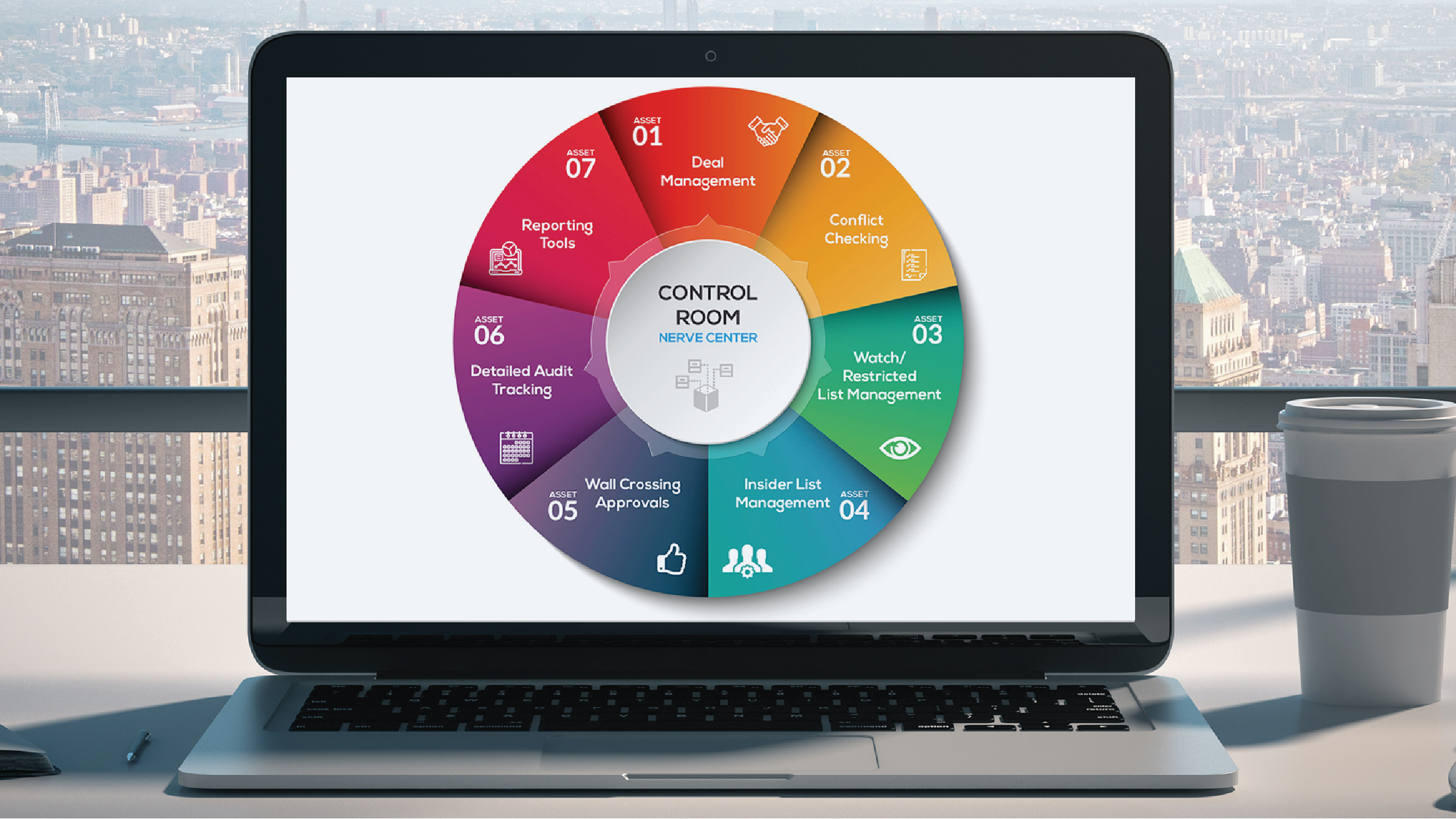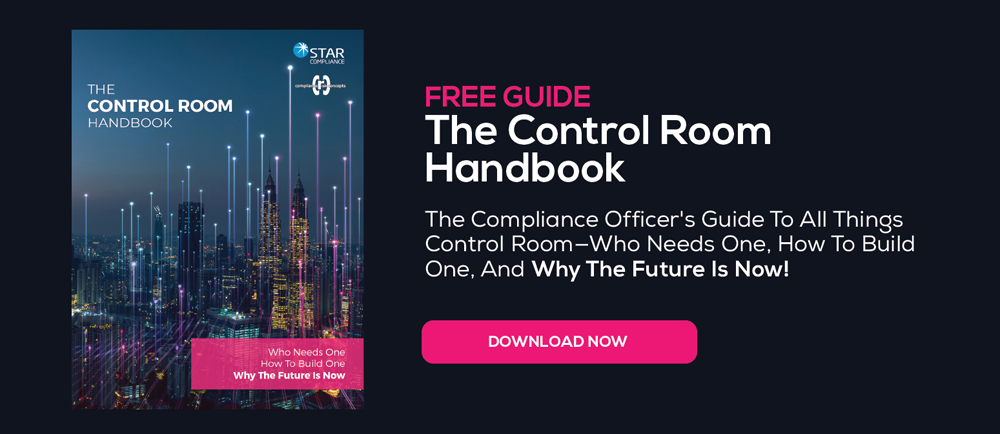New E-Book: The Control Room Handbook
Get happy! Our brand new e-guide on all things control room is about to drop! Learn what’s inside, how it could change the way your firm handles deal-side risk, and how to get your hands on your very own FREE copy
About this time last year, we launched the first iteration of our new control room software: Compliance Control Room. Compliance Control Room revolutionizes the way control rooms are run and risk is managed by funneling critical deal-side data through a single platform that can be monitored with ease. This revolutionary product launch led to another revolutionary idea: author a guide that could walk a firm from start to finish in the building out of a control room. A year later, here we are with that guide: The Control Room Handbook: The Compliance Officer’s Guide To All Things Control Room—Who Needs One, How To Build One, And Why The Future Is Now.
The co-author and subject matter expert of The Control Room Handbook is Steve Brown. Steve has 25 years of capital markets experience and was a pioneer in the control room space. You’ll hear from Steve throughout the guide. And while the title and subtitle give you some indication of what you’ll be getting on the inside, today we’re going to supplement that high-level view with some boots-on-the-ground specifics about what The Control Room Handbook has to offer. We’ll also tell you how you can get your hands on your very own FREE copy.
CONTROL ROOM ORIGINS
In the beginning, there was Ivan Boesky and spreadsheets …
- Control rooms evolved out of compliance departments in the early 1990s, after a series of high-profile inside trading incidents and the passage of the Insider Trading & Securities Fraud Enforcement Act Of 1988. Learn what ITSFEA was all about and why it was so instrumental in the creation of the control room function.
- Learn how a comprehensive SEC review of broker-dealer policies and procedures in 1990 led to the recommendation that firms memorialize their information barrier procedures, and similarly improve the documentation, communication, and recordkeeping associated with such activities.
- Windowless offices. Swivel chairs and banks of monitors. No integrations. Broker-dealer statements piling up on the desk. Long days and nights checking employee trading statements against a spreadsheet, where the watch and restricted lists lived. Learn what life was like for the earliest control room officers.
DO YOU NEED A CONTROL ROOM?
When someone does something they shouldn’t have, and then some …
- There aren’t explicit rules that speak to how a control room should go about its function. Regulations state firms need to have ‘adequate policies and procedures in place to prevent and detect insider trading.’ Learn how firms think about and solve for challenges in the face of such ambiguous guidance.
- Whether or not a firm needs a control room is not black-and-white. Size has something to do with it, but it also comes down to breadth of activity, the amount of MNPI in play, and the kind of business the firm engages in. Learn everything you need to watch out for to determine if a control room is the right next step for your firm.
- There’s a big difference between policy and regulatory violations. You can’t trade on inside information or fail to report watch or restricted list items. These are regulatory violations. Learn more about how to draw the necessary distinctions between these two important categories of information-barrier events.
DETERMINING SCOPE & MANDATE
Wrapping your head around the concept of a control room on a practical level …
- The first step in setting up a control room is to figure out the business—the specifics of what your firm does—to determine control room scope and coverage. What you’ll be doing is starting a conversation with the business. Learn how to start that conversation and keep it going.
- The starting point for determining the scope of the control room and developing a clear mandate is to assess what businesses and employees have access to MNPI and should therefore be monitored by the control room. Find out what your risk assessment should include.
- There’s likely a finite set of bankers at your firm with the experience to work on large, complex transactions. So when it comes to choosing a deal team, your pool of candidates may be limited. Learn all the factors you need to consider when it comes to building conflict-free deal teams.
BUILDING OUT YOUR CONTROL ROOM
Time to think about information barriers, policies, procedures, controls, and training …
- Firms must establish clear barriers to physically and electronically separate employees that deal with MNPI, e.g., private-side employees must be kept separate from employees who recommend security transactions. Learn best practices for building failsafe information barriers.
- Control rooms rely heavily upon watch lists and restricted lists. One of the biggest challenges control rooms face is timely collection of information: to determine if a situation should be added to the watch or restricted list. Learn best practices for keeping these lists up to date.
- The ability to conduct surveillance is critical. Firms must ensure they’re capturing critical activities. But what do you do with this information? How do you record your analysis? Should you attempt to add other tidbits of information into the surveillance? Get expert guidance on all this and more.
OPTIMIZING YOUR CONTROL ROOM
In the modern age optimization means automation, and automation means software …
- Deals are getting more complicated and regulations more complex. Regulators are getting tech savvy, and expect the same from firms: the thinking being, only the latest automated systems can keep a firm running free of conflicts. Learn what this means for your firm in practical terms.
- Good control room software means easy integrations with existing firm systems, including CRM, HR, and research—all of which means simplified scanning of critical deal-data for control room teams. Learn how all of this translates into faster decision making, safer decision making, and less firm risk.
- Because a control room platform is a deal-data centralizer, you can more easily sort through potential conflicts, as spreadsheets, emails, and institutional memory quickly become relics of a past age. Learn all about the game-changing capabilities of modern control room software.
THE FUTURE OF CONTROL ROOM
Reimagining line of sight in the age of coronavirus and remote workforces …
- It’s impossible to say when or if firm employees are going to get back into a physical room. The pandemic has accelerated the automation of control room processes. Learn how enterprise financial firms are reimagining line-of-sight surveillance in the age of COVID-19.
- The control room function is all about tracking behavior from a supervisory perspective. Looking for patterns. Technology can already help with this task, but what else is on the horizon? Get some of the latest blue sky thinking on the future of control room technology.
- Tech is already important, but it’s become more important than ever to know how to partner with third-party vendors in an ever-evolving marketplace and ever-changing regulatory landscape. See how vendor solutions are an easy way to keep on top of situational shifts.
GET YOUR FREE COPY OF THE CONTROL ROOM HANDBOOK
This ends our teaser blog for The Control Room Handbook, but your journey down the path of setting up your own control room or optimizing your existing one is just beginning. The Control Room Handbook is now available. Click on the banner below to download your FREE copy now.





